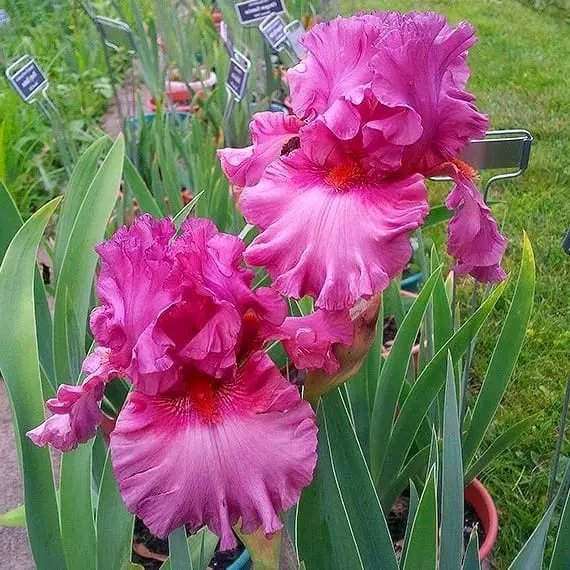Bearded irises are among the most spectacular flowers in the garden. With their extravagant, ruffled blooms and dazzling colors, they make a bold statement in spring and early summer. While they look exotic, they’re surprisingly easy to grow when you understand their unique needs.
This guide covers everything you need to know — from choosing the right rhizomes to enjoying years of reliable blooms.
1. Meet the Bearded Iris
The bearded iris (Iris germanica) is named for the fuzzy “beard” along its lower petals (known as falls). These flowers are available in hundreds of color combinations, many with intricate veining or contrasting beards.
Why gardeners love them:
Dramatic blooms
Wide range of colors
Minimal maintenance once established
Long lifespan (clumps can last decades with care)
2. Choosing the Right Variety
Bearded irises come in several height classes:
Miniature dwarf (8 inches) — great for borders and rock gardens.
Standard dwarf (8–16 inches).
Intermediate (16–28 inches).
Tall bearded (over 28 inches) — the most common and dramatic.
Choose varieties based on bloom time — early, mid, or late season — to extend your iris display over several weeks.
3. The Best Planting Time
The ideal planting period is late summer to early fall (July–September in most climates). This gives rhizomes time to establish before winter.
Planting in spring is possible but may delay blooming until the next year.
4. Location, Location, Location
Bearded irises thrive in full sun, needing at least 6–8 hours daily for strong flowering. Without enough sunlight, they’ll produce lush leaves but few blooms.
Avoid low spots where water collects; irises prefer dry feet. Good air circulation helps prevent fungal problems.
5. Soil Preparation
These plants demand excellent drainage. Heavy clay soils should be amended with sand, grit, or compost to improve structure.
pH preference: Slightly acidic to neutral (6.8–7.0).
Enrichment: Mix in compost or a low-nitrogen fertilizer before planting. Avoid high nitrogen, which encourages leaf growth at the expense of flowers.
6. Planting Bearded Irises
Prepare the bed by loosening soil to 12 inches deep.
Create a small mound of soil in the planting hole.
Place the rhizome on the mound with roots spread down the sides.
Position so the top of the rhizome is just above the soil surface — this exposure helps prevent rot.
Space rhizomes 12–24 inches apart for good air flow.
7. Watering Needs
After planting: Water lightly but regularly until established.
During growth: Water deeply every 7–10 days in dry weather.
After blooming: Reduce water — irises enter a semi-dormant phase.
Overwatering, especially in summer dormancy, can cause rhizome rot.
8. Fertilizing for Blooms
Feed irises in early spring and again just after blooming with a balanced fertilizer (10-10-10) or a low-nitrogen blend.
Avoid fertilizers high in nitrogen, which promote leaves, not flowers.
Scratch fertilizer lightly into the soil, then water in.
9. Seasonal Care
Spring:
Remove mulch if applied in winter.
Inspect for pests and diseases.
Apply spring fertilizer.
Summer:
Deadhead spent blooms to direct energy into the rhizome.
Trim flower stalks to the base after blooming.
Keep leaves intact until they naturally die back — this feeds the rhizome for next year.
Fall:
Cut leaves back to 6 inches after frost.
Divide crowded clumps every 3–4 years (more on this later).
Winter:
In cold zones, a light mulch can protect rhizomes from freeze-thaw cycles — remove early in spring.
10. Dividing and Replanting
Bearded irises need dividing every 3–4 years to stay vigorous. Crowded clumps lead to fewer blooms.
How to divide:
Lift the clump with a garden fork after blooming season.
Cut rhizomes apart, keeping only firm, healthy sections with a fan of leaves.
Trim leaves to 6 inches.
Replant promptly in fresh soil.
11. Pests and Diseases
Common problems:
Iris borer — larvae tunnel into rhizomes, causing rot. Inspect for soft spots and cut out infested parts.
Rhizome rot — often caused by overwatering or poor drainage.
Leaf spot — fungal disease; remove and destroy infected foliage.
Prevention tips:
Space plants for airflow.
Avoid overhead watering late in the day.
Remove old leaves in fall to reduce overwintering pests.
12. Encouraging Show-Stopping Blooms
Keep rhizomes exposed — covering them too deeply can stop blooming.
Plant in full sun.
Fertilize twice a year.
Divide regularly.
13. Using Bearded Irises in the Garden
They’re perfect for:
Perennial borders — dramatic focal points in spring.
Cut flowers — blooms last well in vases when cut early in the morning.
Mass plantings — stunning color blocks.
Pair with peonies, alliums, and late-spring bulbs for extended bloom displays.
14. Annual Iris Care Calendar
January–March
Check stored rhizomes (if lifted) for rot.
Prepare garden beds.
April–May
- Enjoy blooms; deadhead spent flowers.
- Watch for pests.
June–July
- Cut back stalks after bloom.
- Water during dry spells.
August–September
- Divide and replant rhizomes.
- Apply fall fertilizer.
October–December
- Cut leaves back after frost.
- Lightly mulch in cold zones.
🌟 Final Thoughts
Bearded irises are proof that high drama in the garden doesn’t have to mean high maintenance. With the right sun, drainage, and occasional division, they’ll return year after year with dazzling flowers that stop visitors in their tracks.
Once you plant a few, it’s easy to get hooked — there’s a whole world of colors and forms to explore.
More Articles You Might Like
-
Texas Toast Sloppy Joes: The Crunchy, Cheesy Upgrade You Didn’t Know You Needed
There’s something timeless about sloppy joes. For generations, this saucy, savory, and slightly sweet ground beef sandwich has been a go-to comfort food in American kitchens. It’s quick, filling, and family-friendly—perfect for busy weeknights. But what if we told you there’s a way to take this classic dish up a notch? Enter the Texas Toast…
-
Classic Pig Pickin’ Cake
When it comes to Southern desserts, few sweets shine as brightly as the Classic Pig Pickin’ Cake. This nostalgic cake, sometimes called a “Mandarin Orange Cake,” has roots deep in Southern tradition. It gets its playful name from its frequent appearance at pig pickin’s—Southern-style barbecue gatherings where communities come together to enjoy slow-cooked pork, sides,…
-
Lemon Garlic Butter Chicken with Creamy Parmesan Pasta
There’s something irresistible about the combination of tender, golden-browned chicken paired with a creamy pasta coated in Parmesan cheese. Add the brightness of lemon, the depth of garlic, and the richness of butter, and you have a recipe that feels indulgent yet approachable enough for a weeknight dinner. Lemon Garlic Butter Chicken with Creamy Parmesan…



